Crash Course 360°Pack
₹15,000.005 Weeks of Crash Course + Student Visa | Ideal for English medium students or students fluent in English.


Studying in the USA transcends the mere acquisition of a degree; it's an engagement in a vibrant environment that fosters personal development, innovation, and a broad international outlook. With over 1.1 million international students, the United States stands as the premier destination for education globally. It is home to 16 of the top 50 universities worldwide, as per the 2023 QS World Rankings. The nation offers a rich tapestry of cultures, top-notch educational standards, a distinctive curriculum, and a hotbed for innovation, entrepreneurship, and opportunities post-graduation, which are key draws for students worldwide.
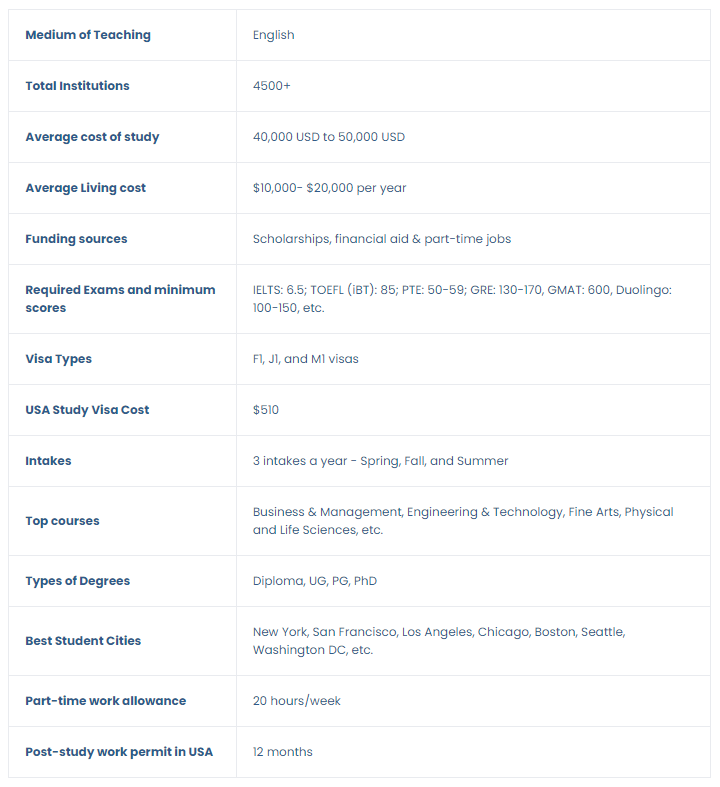
Beyond its appeal as a prime tourist spot, the USA is celebrated for its diverse culture and is the preferred choice for international students. It is particularly renowned for its STEM courses, cutting-edge research, and extensive job opportunities available to students both during and after their studies. In 2022, there were 211,930 Indian students in the US, highlighting its popularity among this demographic. Continue reading for detailed insights on sought-after courses, leading universities, intake sessions for 2023, visa prerequisites, and the top cities for students in the USA.
Key Points on Studying in the USA: Ranked third globally for attracting international students, the USA saw a 19% increase in Indian student enrollments in 2021-22, even outpacing China in the 2022-23 period. During June to August alone, 82,000 US visas were granted to Indian students, the most for any country, underscoring the country's appeal for academic pursuits.
US Education System
The U.S. education landscape is diverse, with institutions categorized into four types: state colleges or universities, private colleges, community colleges, and technical institutes. In the U.S., approximately 4,500 accredited institutions offer three primary degree levels. Like in India, after completing high school, students in the U.S. pursue higher education at either public or private institutions.
Post-high school, the typical undergraduate (Bachelor’s) degree spans four years. At community colleges, an associate degree, akin to a diploma, requires two years of study. For a graduate or Master’s degree at a U.S. university, students invest 2-3 years, while a Ph.D. or doctoral program can take between 5 to 8 years to complete.

Many international students ponder the value of U.S. education. Let’s explore the key benefits that make the U.S. an attractive study destination:
The U.S. higher education system offers immense flexibility in program structure and course selection, enhanced by a credit transfer system and the option for online or in-person classes at convenient times.
The U.S. boasts some of the globe’s most prestigious universities, with degrees that are internationally recognized. Institutions like MIT, Stanford, Harvard, and Caltech consistently top global rankings.
U.S. educational institutions offer a rich student life that includes a variety of extracurricular activities and opportunities for social engagement.
U.S. universities provide an extensive array of STEM programs, granting international students an additional two years of stay after their degree completion. The U.S. also values arts and humanities highly.
With cutting-edge technology and modern educational resources, the U.S. offers abundant research and training opportunities for international students.
Approximately 62% of graduates find employment in the U.S. upon completing their degrees, showcasing the country’s strong job market for graduates.
The United States, encompassing 50 states, is home to globally renowned universities across a variety of vibrant cities, each offering unique educational and professional opportunities. While selecting a university is crucial, understanding the top student cities in the USA can also significantly enhance your study experience. Here's a brief overview:
Understanding the various intake periods in the USA is crucial for planning your overseas education. In the U.S., the academic terms are often referred to as "semesters." Unlike Indian institutions, American colleges and universities typically offer three main admission cycles:
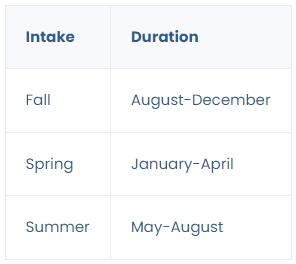
Commencing in September, this intake is favored by many Indian students. It offers a broader range of courses and scholarship opportunities compared to other periods.
Begins in January and is an alternative for students who may have missed the fall intake.
Starts around May and tends to have fewer available programs and courses, as it is not as common as the fall and spring intakes.
Embarking on your educational journey in the USA, whether for a short course or a full degree program, involves a comprehensive 6-step process:
Begin by thoroughly researching potential study opportunities in the USA, including top universities and courses. Investigate financial aid and scholarship options provided by universities to support your education.
Understand the financial requirements of studying in the USA. Costs can vary, with undergraduate programs ranging from $15,000 to $55,000 USD annually, and postgraduate programs costing between $15,000 and $30,000 USD per year.
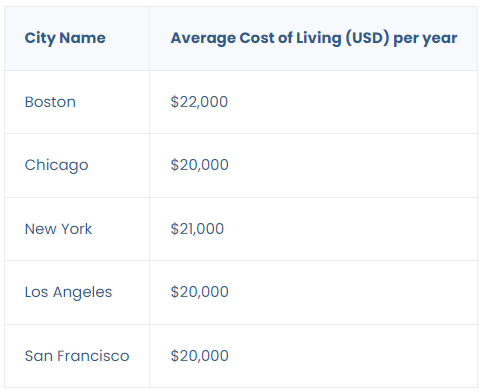
Start your application early, focusing on creating a strong profile that includes a statement of purpose, letters of recommendation, a personal essay, and preparing for any interviews.
Take necessary standardized tests such as the IELTS, TOEFL, PTE for English proficiency, and the GRE, GMAT, SAT, or ACT, depending on your chosen program's requirements.
After securing an admission offer and receiving the I-20 form, proceed to apply for a student visa at the nearest U.S. embassy or consulate.
Once your visa is approved, notify your university, gather necessary immigration and pre-departure documents, pack your belongings, and get ready for your new academic adventure in the USA.
The dedicated instructors of The English Channel are passionate about adapting their teaching methods to fit each student's unique needs.
We prioritize creating the optimal learning environment, making your journey to IELTS success both swift and straightforward.
Leading universities in the USA are renowned for their exceptional teaching quality and educational frameworks, playing a crucial role in fostering the comprehensive growth of their students. Below is a list of esteemed universities in the USA where you can pursue your studies:
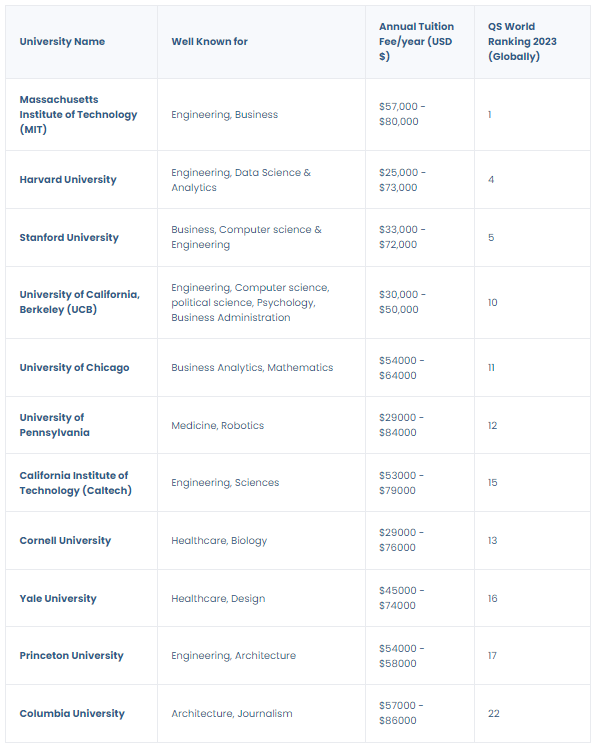
The USA is celebrated for its prestigious educational institutions, offering top-tier programs that provide deep and engaging learning experiences. Below is a curated list of the most sought-after courses for international students in the USA, featuring a strong emphasis on STEM disciplines alongside other notable fields:
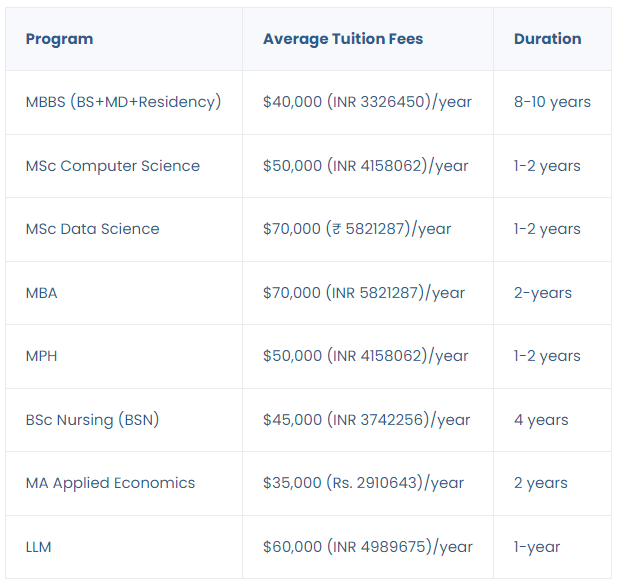
For those interested in groundbreaking research and innovation in areas like neuroscience and climate change, top-tier institutions for bachelor’s programs include MIT, Yale, UCLA, Georgia Institute of Technology, University of Colorado Denver, and Washington State University.
Tuition fees for these popular programs in the USA typically range between USD 40,000 and USD 50,000 per annum.
Understanding the requirements for a U.S. student visa is essential for international students. The U.S. issues three main student visas: F-1 (most common), J-1, and M-1. For comprehensive details, visit the U.S. Department of State's website. Here's a simplified application process:
1. Secure admission to an SEVP-approved school or program in the USA, ideally 6 to 12 months before your program begins.
2. Receive an I-20 or DS-2019 form from your institution, necessary for the visa process.
3. Pay the SEVIS fee at least three days before applying for your visa, with options for online or paper payment detailed on the ICE SEVP website.
4. Book an appointment at your local U.S. consulate or embassy.
5. Pay the required Machine Readable Visa (MRV) fee.
6. Attend your visa interview with all required documents, as listed on the embassy’s website. Remember to fill out the DS-160 Visa application form online beforehand.
Arrive early for your interview and consider using the Offsite Facilitation Center (OFC) services for additional support.
Required documents generally include your personal information, contact details, passport specifics, travel history, educational and employment background, English proficiency scores, medical information, proof of financial stability, and your SEVIS ID along with the address of the U.S. institution (from the I-20 or DS-2019 form).
The F-1 student visa is a common choice for Indian students heading to the USA. Applicants can initiate the student visa process up to 365 days prior to their course's commencement. However, they are allowed to enter the USA no more than 30 days before their classes begin.
The application fee for an F-1 student visa is USD $510, equivalent to approximately INR 42,203. It's advisable to apply well in advance to ensure there's sufficient time for the processing of your application. This early start also provides you with ample time to gather any additional documents needed for your visa and university applications.
Scholarships are typically awarded to candidates following interviews with admissions representatives. International students looking to study in the USA have access to a variety of scholarships, including those funded by government bodies, non-governmental organizations, and specific universities. These scholarships are often awarded based on academic merit or outstanding performance in extracurricular activities. For Indian students aiming to minimize their educational expenses in the USA, it's crucial to be aware of and apply for the top scholarships available. Here's what you need to know:
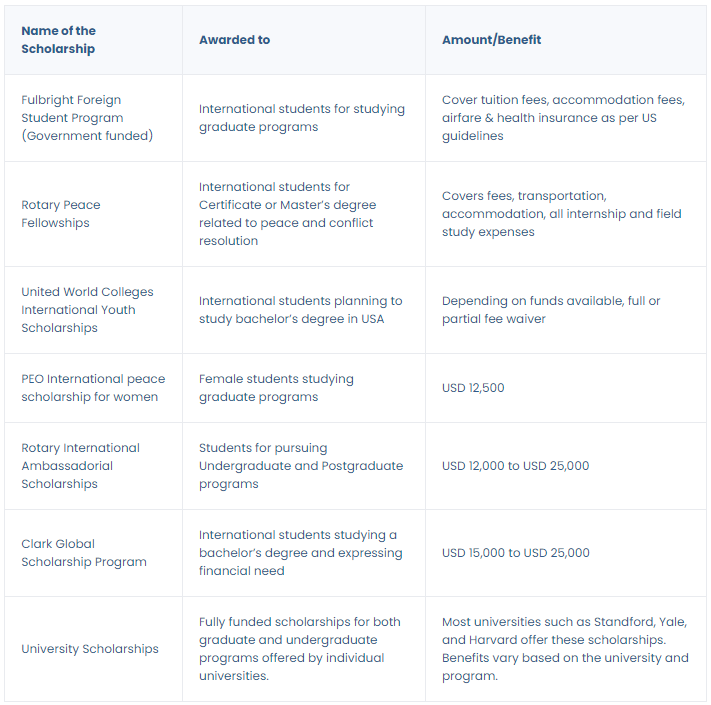

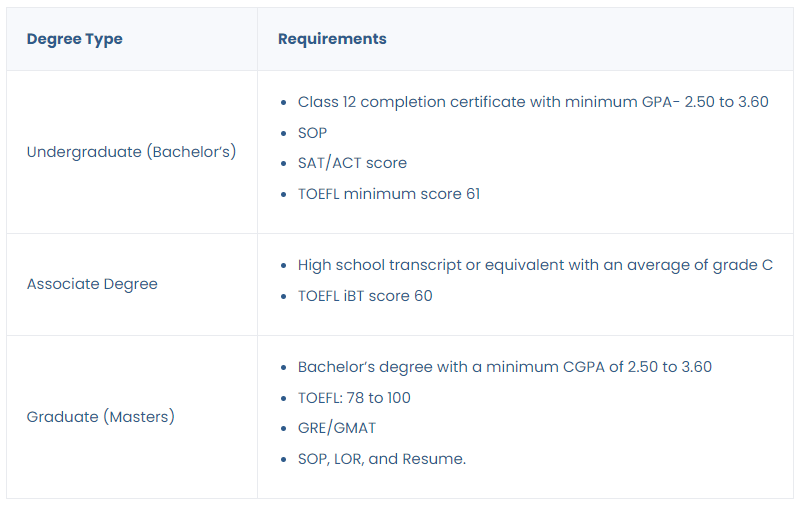
The minimum scores for standardized and English language tests vary depending on the university and program. Academic transcripts are evaluated and converted to the U.S. grading system, often through services like WES (World Education Services). Understanding the conversion from CGPA to the U.S. GPA system can also aid students in assessing their eligibility, particularly with the American 4-point grading scale.
For those interested in specific degree requirements, additional details can be provided to tailor your preparation accordingly
Studying in America can be expensive, but financial aid, scholarships, and loans can help. Here are some key points to consider:
Financial Aid Options: Explore scholarships, grants, and loans to fund your education.
Eligibility Criteria: Understand the requirements for loan approval to make the process smoother.
Finding the Right Loan: Look for a loan that fits your budget and needs.
Expert Assistance: At TEC, you can get expert help with loan negotiation, finding education grants, and securing quick loan approval for studying abroad.
Cost of Studying in the USA
The cost of studying in the USA ranges from $7,000 to $55,000 per year, depending on the course and university. For full-time courses, the cost per semester is between $3,500 and $27,000. The overall cost is divided into two main categories: tuition fees and living expenses.
Tuition Fees:
Public 2-Year College: Average tuition fee is $13,470 (INR 11.20 lakhs) per year.
Public 4-Year College: Average tuition fee is $40,550 (INR 33.72 lakhs) per year.
Private 4-Year College: Average tuition fee is $53,430 (INR 44.43 lakhs) per year.
Living Expenses:
Includes accommodation, food, transportation, and other personal expenses.
Additional support is available through scholarships, bursaries, paid internships, and part-time work opportunities.

The average cost of living in the USA ranges from $2,500 to $3,500 per month, depending on location and lifestyle. The two primary components of living expenses are accommodation and meals. Here are some key points to consider:

Accommodation:
Student accommodation is a budget-friendly option.
Living costs are higher in cities compared to suburban areas.
Meal Expenses:
Costs will vary based on eating habits and dining choices.
General Living Expenses:
These include transportation, utilities, entertainment, and personal items. When planning your budget, remember that some expenses are unavoidable. Below is a breakdown of typical living expenses for international students in the US:
While studying in the USA, students have the opportunity to engage in part-time employment, with options for working either on-campus or off-campus. On-campus employment allows students to work within their college or university's premises, while off-campus employment is typically related to their field of study.
For off-campus work, students can explore four main categories: Optional Practical Training (OPT), Curricular Practical Training (CPT), jobs due to economic hardship, and positions with international organizations.
Students are permitted to work up to 20 hours per week during the academic term and full-time during breaks or upon completing their studies. The federal minimum wage in the USA is $7.25 per hour, but this can vary as each state has the authority to set its own minimum wage, with figures ranging between $7.25 to $15 per hour.
Here's a list of some common part-time jobs in the USA along with their average hourly wages:
Upon completing your education, you may explore employment opportunities to achieve a favorable Return on Investment (ROI). International students holding F-1 visas are typically permitted to work in the USA post-graduation, adhering to the guidelines and restrictions set by USCIS. Salaries for graduates can range widely, from approximately USD 53,000 to USD 157,000 annually.
The U.S. job market experiences skill shortages in various sectors, creating strong demand for graduates, particularly in fields like healthcare, real estate, film production, retail, agriculture, engineering, and IT. According to the Bureau of Labor Statistics, the U.S. is expected to add 8.3 million new jobs from 2021 to 2031, with about 23.1% (1.9 million) of these new opportunities projected in the leisure and hospitality sector.
Below is an overview of potential career paths for graduates from U.S. universities, along with the anticipated salary ranges:
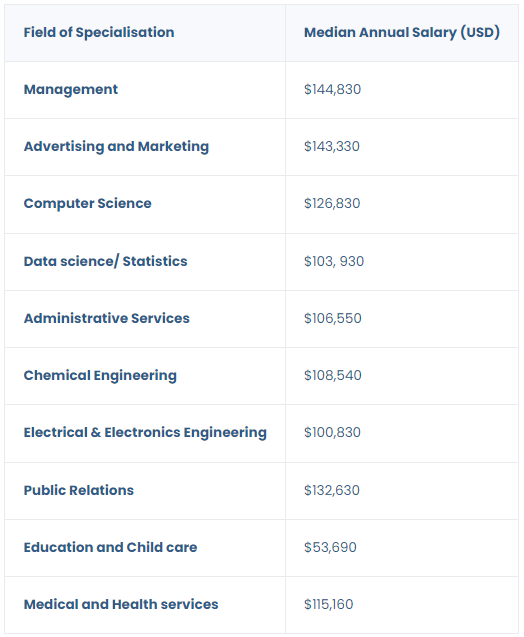
In conclusion, like any other country, the USA has its own set of advantages and challenges. However, pursuing education and gaining global exposure at esteemed American universities can have a profound impact on your personal and professional growth, steering you towards sustained success. If you're contemplating studying abroad, the United States offers a wealth of opportunities for higher education. Hopefully, this information provides a comprehensive overview of what you need to know to study in the USA. Why delay? Take the next step to make your American education dream a reality! For personalized guidance throughout your journey, TEC is here to assist you. We're just a phone call away.

5 Weeks of Crash Course + Student Visa | Ideal for English medium students or students fluent in English.
Career Counselling & Assessment |
Courses & Program Selection |
Education Loan Processing |
SOP Writing & Guidance |
Student Visa Process (Canada & UK) |
Pre Departure Counselling |
Generally, international students pursuing undergraduate degrees pay about $36,100 annually, whereas those enrolled in graduate programs typically incur tuition fees of approximately $21,100 each year, according to data from Statistics Canada in 2022.
While Canadian universities do not offer tuition-free education, it is not entirely impossible for international students to study without bearing costs. Institutions such as the University of Toronto and the University of Alberta provide full scholarships that can cover the expenses for eligible international students.
To secure a student visa for Canada, you must show a bank balance of at least $10,000 CAD. For those planning to pursue studies in Canada, demonstrating financial capability with at least $25,000 CAD in your bank account is essential.
You are eligible to sponsor or receive sponsorship from a range of family members, including your spouse, common-law partner, conjugal partner, child, parent, grandparent, orphaned sibling, orphaned nephew or niece, and orphaned grandchild. For information on obtaining a spouse visa for Canada, you can find guidance here.
Generally, a gap of up to two years in education is considered acceptable for students aiming to study in Canada, though the acceptance of a study gap may vary depending on the specific university and the program's criteria.
Yes, degrees earned from Canadian institutions are recognized globally and renowned for their high-quality education.
Leading Canadian universities usually have acceptance rates ranging from 40% to 60%. Notable universities with higher acceptance rates are the University of Brunswick at 74%, Toronto Metropolitan University and Lakehead University each at 55%, and both the University of Montreal and the University of Guelph at 50%.
Yes, an MBA degree obtained from Canada is acknowledged worldwide, including in India. However, many graduates of Canadian MBA programs opt to remain in Canada post-graduation, attracted by the competitive salaries, ample job prospects, and the high standard of living.
After applying for the visa, the subsequent phase is the visa interview, which can be somewhat daunting and may result in visa denial if not handled well. Therefore, it's crucial to prepare thoroughly by familiarizing yourself with the frequently asked questions in Canada visa interviews to enhance your chances of success.